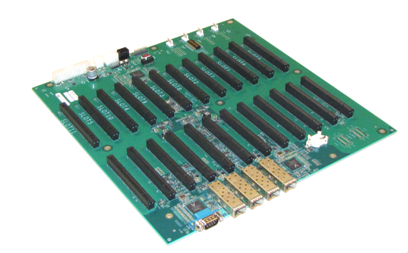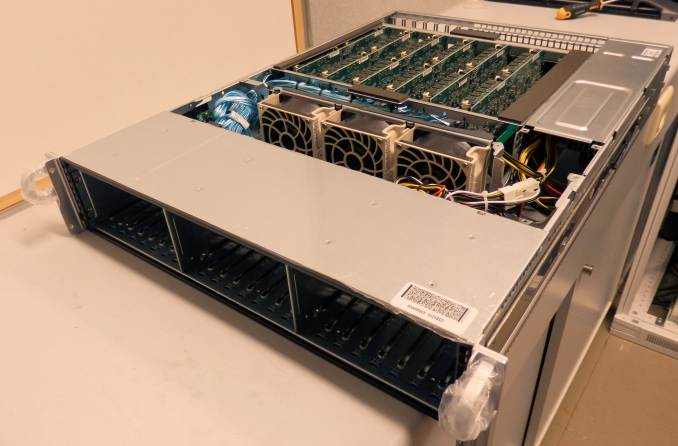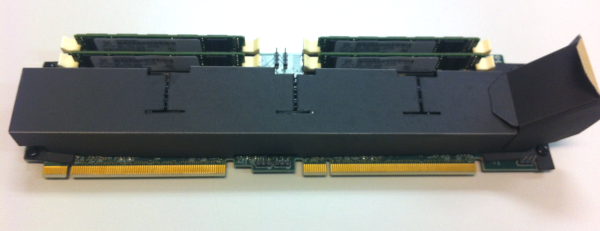Calxeda's ARM server tested
by Johan De Gelas on March 12, 2013 7:14 PM EST- Posted in
- IT Computing
- Arm
- Xeon
- Boston
- Calxeda
- server
- Enterprise CPUs
It's a Cluster, Not a Server
When unpacking our Boston Viridis server, the first thing that stood out is the bright red front panel. That is Boston's way of telling us that we have the "Cloud Appliance" edition. The model with an orange bezel is intended to serve as a NAS appliance, purple stands for "web farm", and blue is more suited for a Hadoop cluster. Another observation is that the chassis looks similar to recent SuperMicro servers; it is indeed a bare bones system filled with Calxeda hardware.
Behind the front panel we find 24 2.5” drive bays, which can be fitted with SATA disks. If we take a look at the back, we can find a standard 750W 80 Plus Gold PSU, a serial port, and four SFP connectors. Those connectors are each capable of 10Gbit speeds, using copper and/or fiber SFP(+) transceivers.
When we open up the chassis, we find somewhat less standard hardware. Mounted on the bottom is what you might call the motherboard, a large, mostly-empty PCB that contains the shared Ethernet components and a number of PCIe slots.

The 10Gb Ethernet Media Access Controller (MAC) is provided on the EnergyCore SoC, but in order to allow every node to communicate via the SFP ports, each node forwards its Ethernet traffic to one of the first four cards (the cards in slots 0-3). These nodes are connected via a XAUI interface to one of the two Vitesse VSC8488 XAUI-to-serial transceivers that in turn control two SFP modules each. Hidden behind an air duct is a Xilinx Spartan-6 FPGA, configured to act as chassis manager.
Each pair of PCIe slots contains what turns this chassis into a server cluster: an EnergyCard (EC). Each EnergyCard contains four SoCs, each with one DIMM slot. An EnergyCard contains thus four server nodes, with each node running on a quad-core ARM CPU.
The chassis can hold as many as 12 EnergyCards, so currently up to 48 server nodes. That limit is only imposed by physical space constraints, as the fabric supports up to 4096 nodes, leaving the potential for significant expansion if Calxeda maintains backwards compatibility with their existing ECs.
The system we received can only hold 6 ECs; one EnergyCard slot is lost because of the SATA cabling, giving us six ECs with four server nodes each, or 24 server nodes in total. Some creative effort has been made to provide air baffles that direct the air through the heat sinks on the ARM chips.
The air baffles are made of a finicky plastic-coated paper, glued to gether and placed on the EC with plastic nails, making it difficult to remove them from an EC by hand. Each EC can be freely placed on the motherboard, with the exception of the Slot 0 card that needs a smaller baffle.
Every EnergyCard is thus fitted with four EnergyCore SoCs, each having access to one miniDIMM slot and four SATA connectors. In our configuration each miniDIMM slot was populated with a Netlist 4GB low-voltage (1.35V instead of 1.5V) ECC PC3L-10600W-9-10-ZZ DIMM. Every SoC provided was hooked up to a Samsung 256GB SSD (MZ7PC256HAFU, comparable to Samsung’s 310 Series consumer SSDs), filling up every disk slot in the chassis. We removed those SSDs and used our iSCSI SAN to boot the server nodes. This way it was easier to compare the system's power consumption with other servers.
Previous EC versions had a microSD slot per node at the back, but in our version it has been removed. The cards are topology-agnostic; each node is able to determine where it is placed. This enables you to address and manage nodes based on their position in the system.














99 Comments
View All Comments
thenewguy617 - Wednesday, March 13, 2013 - link
I would like to see the results with the website running on bare metal. I would like to, but I don't believe you when you say the virtualization overhead is minimal.Also, did you include the power used by the switch? as we scale the xeon cluster we will add a lot of cost and power in the network, however Calxeda fabric should scale for free.
thebeastie - Thursday, March 14, 2013 - link
I think a lot of you are missing the main point or future potential of this server technology. And that is that intel like to make an absolute minimum of $50 per CPU they make, in server CPUs it's more like $300.These Arm CPUs are being sold at around $10 a CPU.
Sure Caldexa have gone the hard yards making such a server and want a lot of money for it. BUT once these ARM servers are priced in relative context of their actual CPu costs its going to be the biggest bomb drop on Intels sever profits in history.
Silma - Thursday, March 14, 2013 - link
Assuming you are right and ARM is becoming so important that it can't be ignored, what's to prevent Intel to produce and sell ARM itself? In fact what's to prevent Intel to produce the best ARM socs as it has arguably the best fabs?There are rumors that Apple is asking Intel to produce procs for them, this would certainly be very interesting if it proves to be true.
thebeastie - Friday, March 15, 2013 - link
The fact that Intel would practically look at other businesses then produce SoC/CPUs for $10 each, x86 or ARM based doesn't matter in the face of such high portability of code.Metaluna - Friday, March 15, 2013 - link
The problem is that ARM cores are pretty much a commodity, so ARM SoC pricing is inevitably going to end up as a race to the bottom. This could make it difficult for Intel to sustain the kind of margins it needs to keep it's superior process R&D efforts going. Or at least, it would need to use its high-margin parts to subsidize R&D for the commodity stuff which could get tricky given the overall slowing of the market for the higher end processors. I think this is what's happening with the supposed Apple deal. There have been reports that they have excess capacity at 22nm right now so it makes sense to use it. And, since Apple only sells its processors as part of its phones and tablets, it doesn't directly compete with x86 on the open market.Of course, all the other fabs are operating under the same cost constraints, so there would be an overall slower pace of process improvements (which is happening anyway as we get closer to the absolute limits at <10nm).
wsw1982 - Wednesday, April 3, 2013 - link
And so does those companies, run into bottom. What can they do to even their R&D, by put the server chip into mobile phone?Krysto - Monday, March 18, 2013 - link
Yup. This is actually Intel's biggest threat by far. It's not the technical competition (even though Intel's Atom servers don't seem nearly as competitive as these upcoming ARM servers), but the biggest problem by far for them will be that they will have to compete with the dozen or so ARM server companies on price, while having more or less the same performance.THAT is what will kill Intel in the long term. Intel is not a company built to last on Atom-like profits (which will get even lower once the ARM servers flood the market). And they can forget about their juicy Core profits in a couple of years.
wsw1982 - Wednesday, April 3, 2013 - link
So your argument is because the ARM solution is more expensive than Intel solution now, therefore it must be cheaper than Intel solution in the feature? The mobile ARM is cheap, so does the Intel mobile chips.Silma - Thursday, March 14, 2013 - link
1300$ difference / server, that's a lot electricity you have to spare to justify the cost, especially as it is better that Xeon servers only in a few chosen benchmarks.Can't see how this is interesting in production environment.
It's more for testing / experimenting I guess;
Wilco1 - Thursday, March 14, 2013 - link
The savings are more than just electricity cost, you also save on cooling costs and can pack your server room more densely. If you do a TCO calculation over several years it might well turn out to be cheaper overall.This is the first ARM server solution, so it's partly to get the software working and test the market. However I was surprised how competitive it is already, especially when you realize they use a relatively slow 40nm Cortex-A9. The 2nd generation using 28nm A15 will be out in about 6 months, if they manage to double performance per core at similar cost and power then it will look even better.